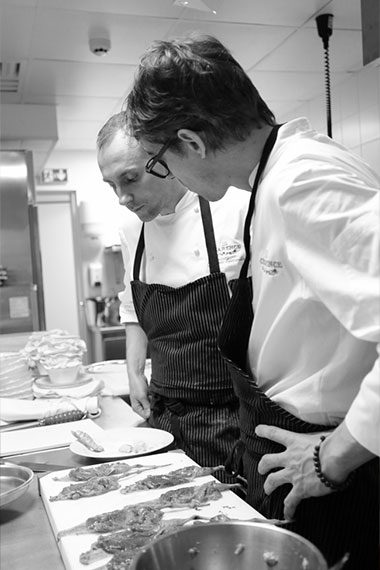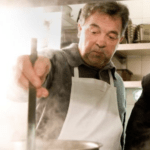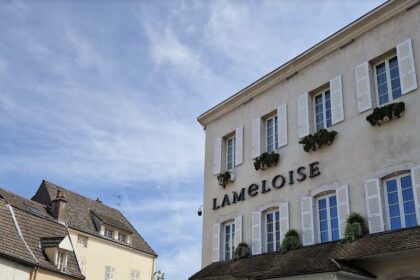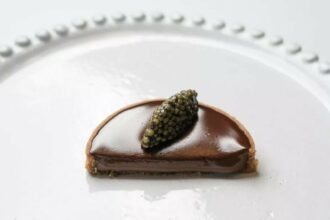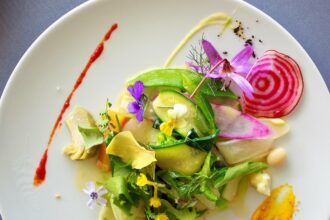This relatively new high end dining restaurant in Paris has all kinds of features we love to hate. It has two gorgeous small salons equipped with red velvet chairs, a glittering forest of crystal glasses, an armory of silver cutlery, beautiful candles, and very professional well-dressed servers who effortlessly build a rapport with diners without being patronizing and too intrusive. This is all very anachronistic in an age where most of us, including French restaurant critics, feel threatened by “la grande cuisine française dans sa plus belle tradition.”
Possibly there has never been an era in history, with so many diners with some tie to social media, who take themselves seriously while displaying an inverse relationship between knowledge and their inflated sense of self-worth. In contrast, the so called “leading 50 restaurants of the world”, with chefs who are “creative artists” rather than “artisans/ouvrier”, now serve a long series of incomplete “ideas” that are beautiful to photograph for Instagram, with waiters who have memorized lectures on the source of each ingredient. Because these restaurants know how to cater to these “influencers” and “media personalities,” they have succeeded in creating a demand for almost anything that they cook, independent of taste, as long as the dishes look good to photograph. Because the globe-trotting “influencers” have been paid to promote restaurants that are sponsored by business conglomerates, the overall result has been the decline of true fine-end destinations, in general, and “la grande cuisine francaise,” in particular.
But “la grande cuisine francaise” is not yet gone.
How else can one explain the sudden arrival of Le Clarence onto the dining scene in Paris? It is really rowing against the tide. With some possible exceptions, there are not too many Michelin three star or top 20 restaurants in the Western world which cook without a nod to Japan, to Kaiseki, and to Nordic fads. Luxury ingredients, such as caviar, lobster, foie gras, are on the unofficial black list in favor of ingredients supposedly foraged from the forest. There is nothing wrong with this, except that we are witnessing the transformation of chefs from kitchen professionals to media oriented, story-telling narrators.
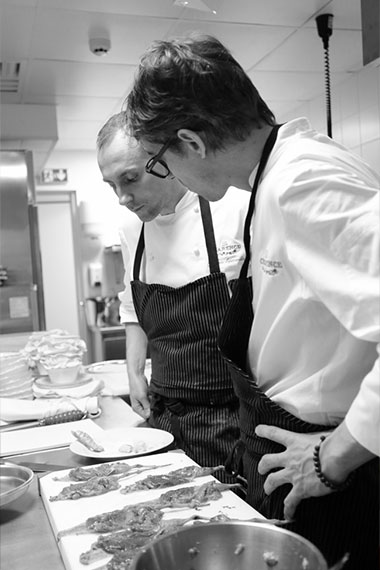
Le Clarence chef Christophe Pele and second chef Giuliano are true professionals with an identity. I am familiar with their style from the La Bigarrade days in the 17th arrondissement, which was a small space with a cheery atmosphere. The chefs especially favored shellfish which was cooked with the precision of the great Spanish masters. The French often overcook the seafood. They have shown the typical obsession of great French chefs for getting every detail right and for achieving an overall harmony. The cooking was elaborate, but not fussy. The emphasis on the best possible ingredients was on par with L’Astrance (It was Monsieur Rohat who recommended this restaurant to me). The sommelier was capable of pairing the dishes with inexpensive great wines. Overall La Bigarrade was like a hidden gem, and I had hoped that it would stay that way.
Well, it did not stay that way, as the chefs sold the restaurant. Five to six years later Christophe and Giuliano reappeared on to the Paris scene in a diametrically opposite, very luxurious, yet refined environment. The basic tenets of their cooking philosophy remained unaltered: top quality ingredients, focused and precise cooking that shows respect for products, and combinations which are complimentary and well thought out in the sense that the elaboration of a given product is solely aimed at adding an extra layer of complexity without losing the overall harmony. There is almost an obsession with detail that is not aimed to impress the chef’s ego or to show his “pseudo-cerebral” approach to cooking. Instead, the tremendous work and detail is disguised so well that one can surmise that the only concern of the chefs is to cook what they themselves love to eat on special occasions. This is why they are great chefs, and this is why this exquisite restaurant will never top any list or become too trendy.
The one salient difference between La Bigarrade and Le Clarence is that they now use more luxurious ingredients, such as caviar and lobster. I love that! So far we have visited the restaurant only twice, mid-March and July 3rd. Here is a brief summary:
March 2018 Meal
It is sometimes possible to drink your champagne and taste amuses in the beautiful 3rd floor room, before being ushered to your table. Bereche et Fils is lean and minerally. Amuses are just right in number, such as an excellent gougere (only Pacaud offers it); a puff pastry with tender spinach and ricotta; and gratineed clams.
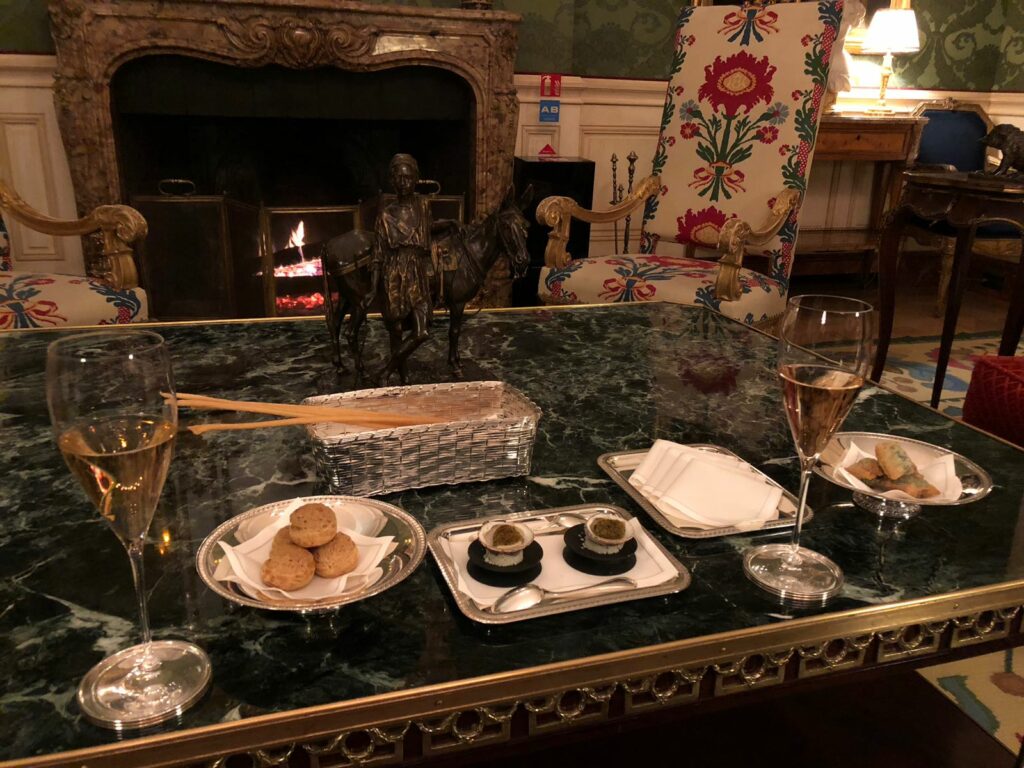
The March meal started with an oyster wrapped in kadaif, topped by blood orange and a kiss of XO sauce. It had well-calibrated flavors, with the sharpness of XO sauce cut by blood orange. We tasted Petit @ Bajan “Nymphea” rose champagne with it. We were taken aback by the deliciousness of the brioche and the quality of their bread.
Kessler Alsace Grand Cru 2014 Dirler-Cade was served with the second course: scallops in two forms. The raw scallop was dressed with a cream of buffalo and sat on top of baby veal tartare from Correze. It was delicious. Equally good was the barely grilled scallop with amazing tangerine from Sicily and sorrel cream. This dish tasted like a burst of flavors with intensity which paired very well with the Riesling. The Riesling had good tension and an agrume component.
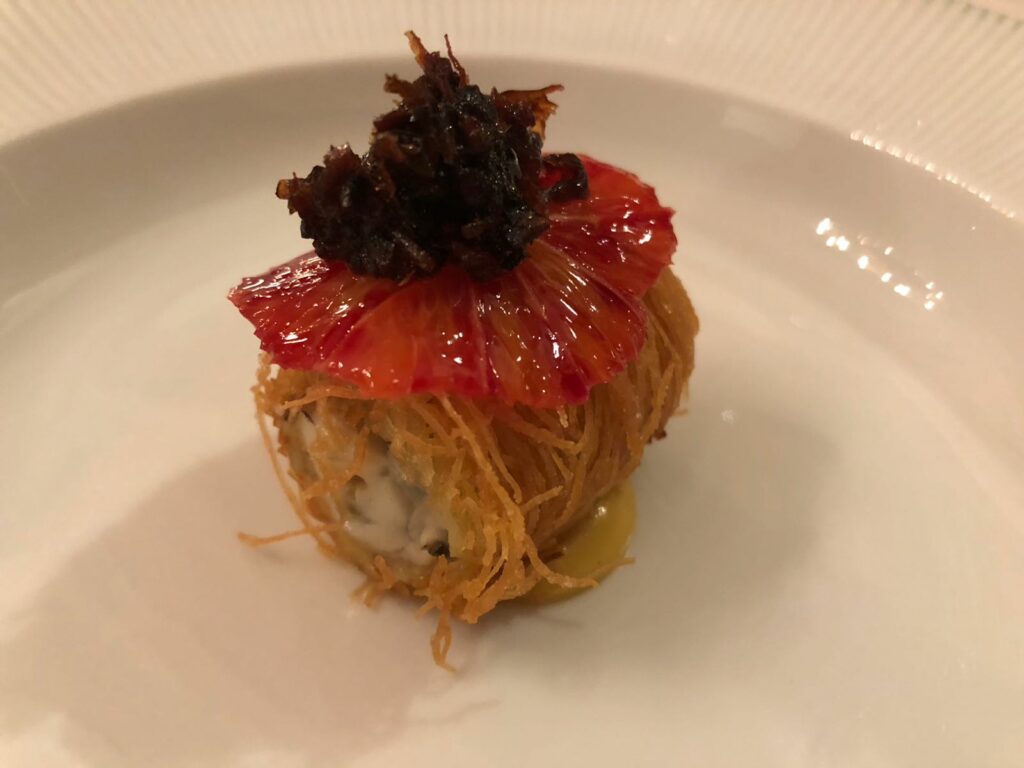
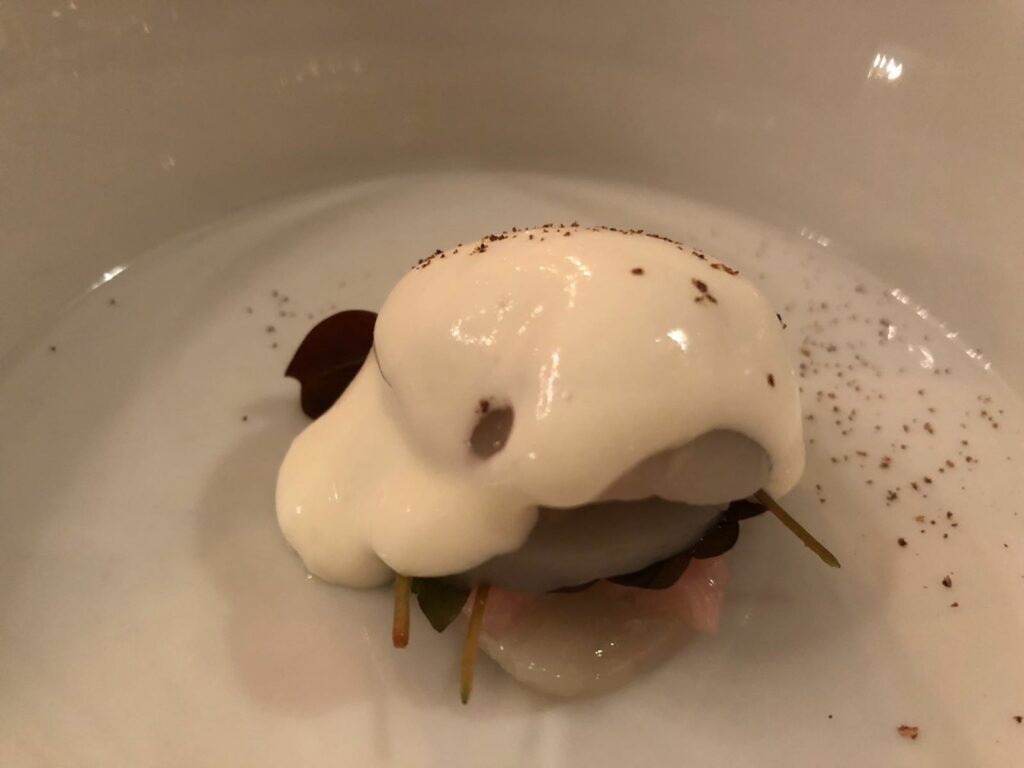
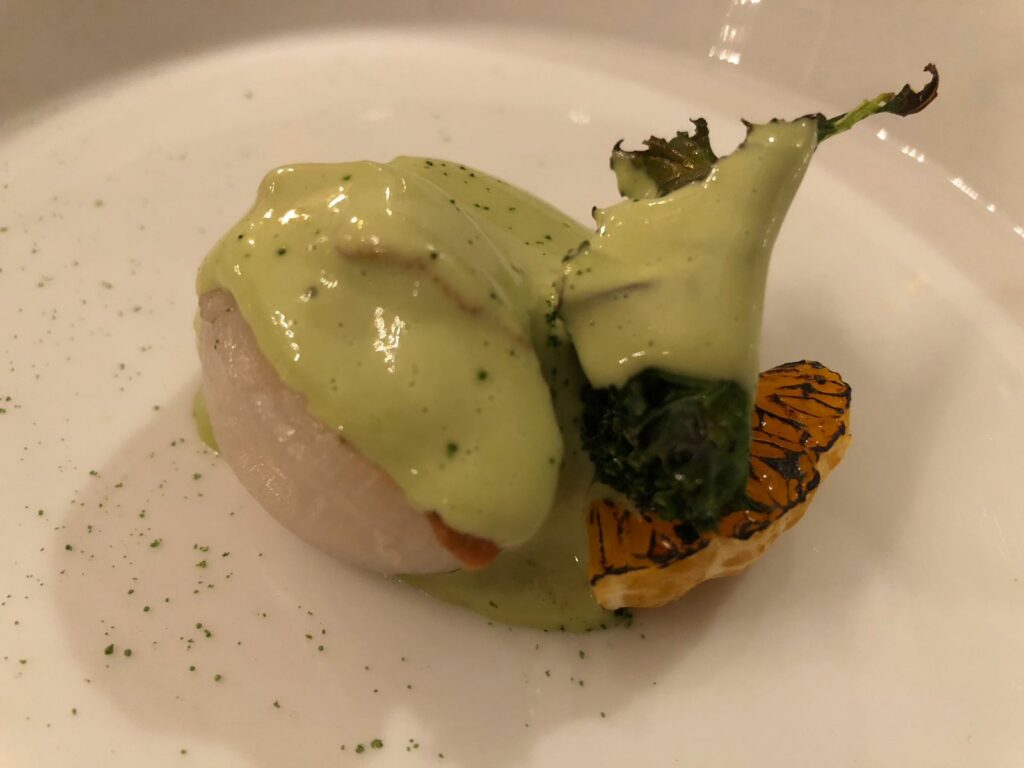
Then we were served rouget. It is translated as “red mullet,” but I never saw and nor wish to see “red mullet”. The chefs handled the fish perfectly, i.e. they did not compromise the firm flesh, yet the fish retained its juiciness. The fish was wrapped in lard of Colonnata and topped by lamb kidney. There was a little emulsion of veal jus. I guess the chefs wanted to emphasize the meaty qualities of the rouget, but I think Akihiro’s (Table d’Aki) handling of rouget with acidulated carrots with cumin stays a reference point for me. The wine did not pair well with the dish.
Nonetheless the chefs had a surprise which showcased the rouget’s freshness: its liver. The perfect asparagus from Provence (first of the season from Domaine de Rogue-Hautes in Aix-en Provence) was topped by bitter/sweet/saline rouget liver. A touch of blood orange jelly at the bottom and a sprinkle of toasted sesame seeds elevated this crunchy/grassy-almost minerally, perfect asparagus to a higher plane. This was a textbook example of what “la grande cuisine Francaise” meant before it became abused and distorted to suit social media. The Riesling was a good match this time.
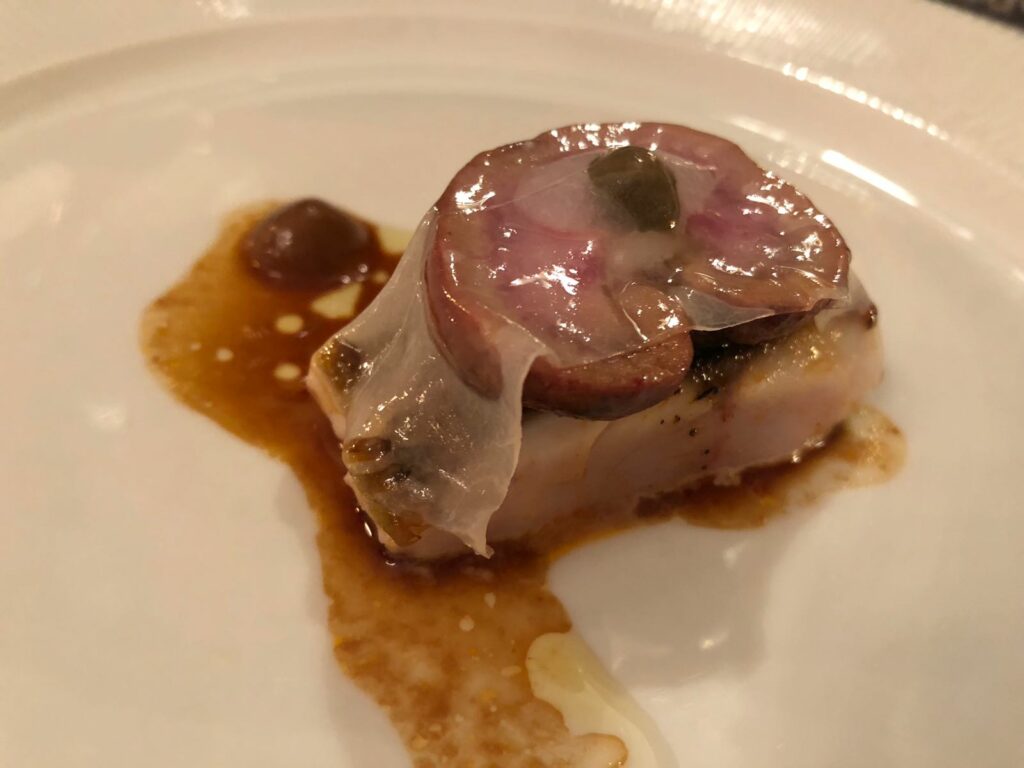
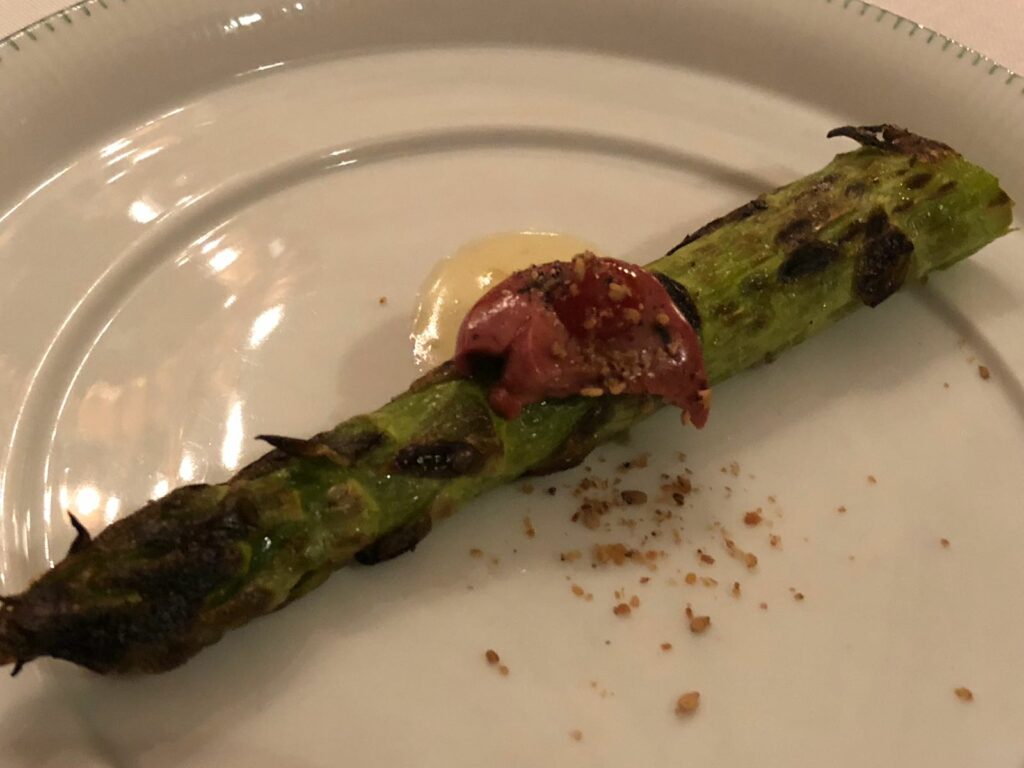
Next they came to present us with about a 700 grams blue lobster from Brittany which was alive. Unlike the Maine lobsters, lobsters from Brittany taste best between 600 grams to a kilo. The lobster tail was perfectly cooked a la plancha (a technique I do not find too often in France) and dipping it in a sabayon of Fresh herbs was delightful. The tail was lacquered with a jus of crustaceans that imparted depth. The claw of lobster, served as tempura with caviar, was also fantastic. The daurenki caviar from Petrossian (from a lake that borders Russia and China) is very buttery and nutty when it is so fresh, and if you do not compare it with the Iranian wild beluga of the past, you will like it. At any rate, the briny-poppy caviar goes so well with the sweet-saline lobster. I wish we were drinking a properly aged Coche or Roulot Meursault with it but the Jean-Marc Vincent 2011 Santenay 1er cru “Les Gravieres” white did not disappoint, with its well-integrated oak and nice fruit-acid balance. The third component of the dish, a black ravioli (sepia ink), stuffed with bigorre ham and walnuts was fantastic. The veal tonnato cream lightened by lemon rind needed to be swallowed with the ravioli in a single bite to experience the explosion of complimentary flavors. Interestingly the server did not say anything about it as Le Clarence seems to respect the intelligence of the customer instead of having the typical patronizing attitude.
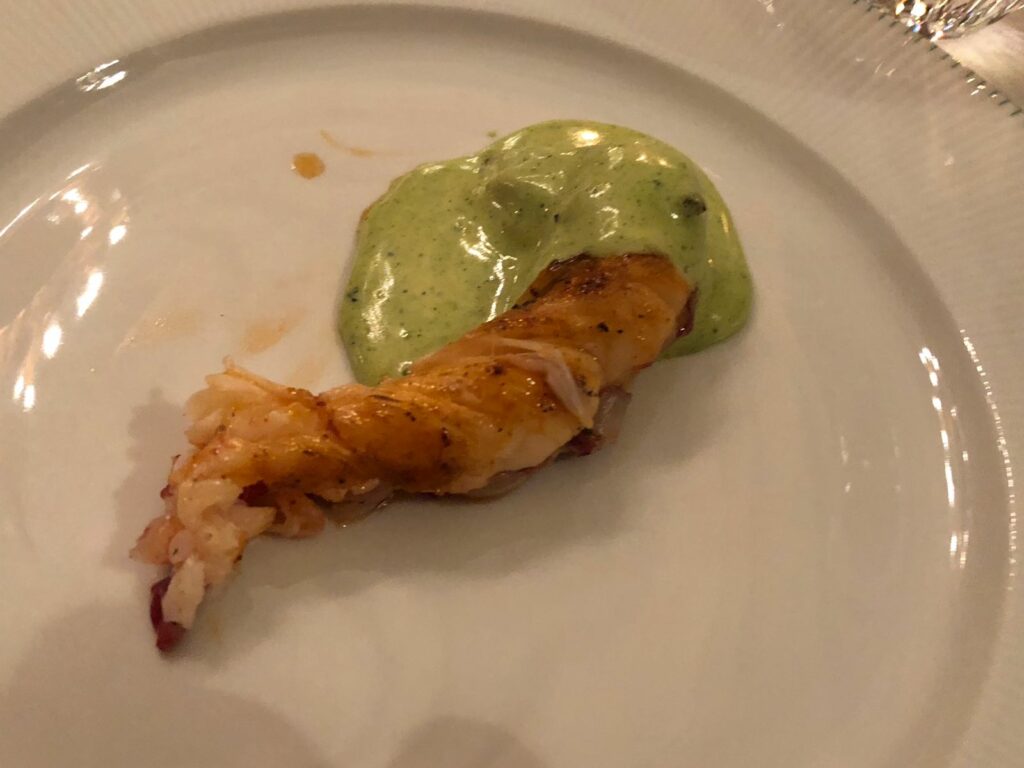
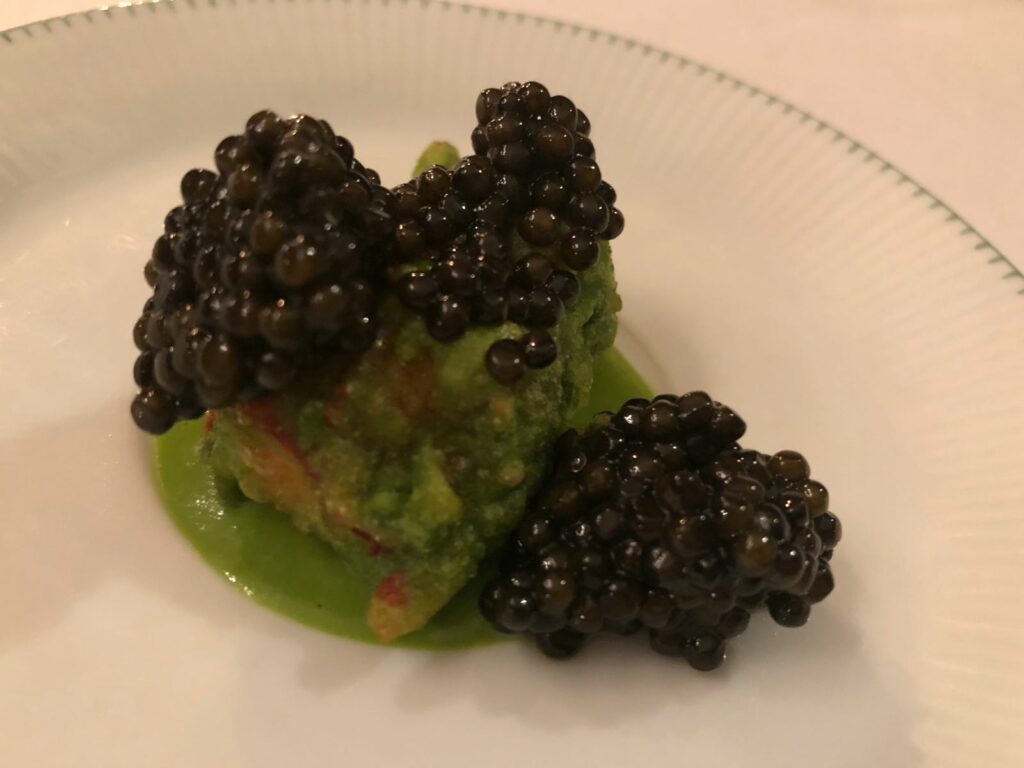
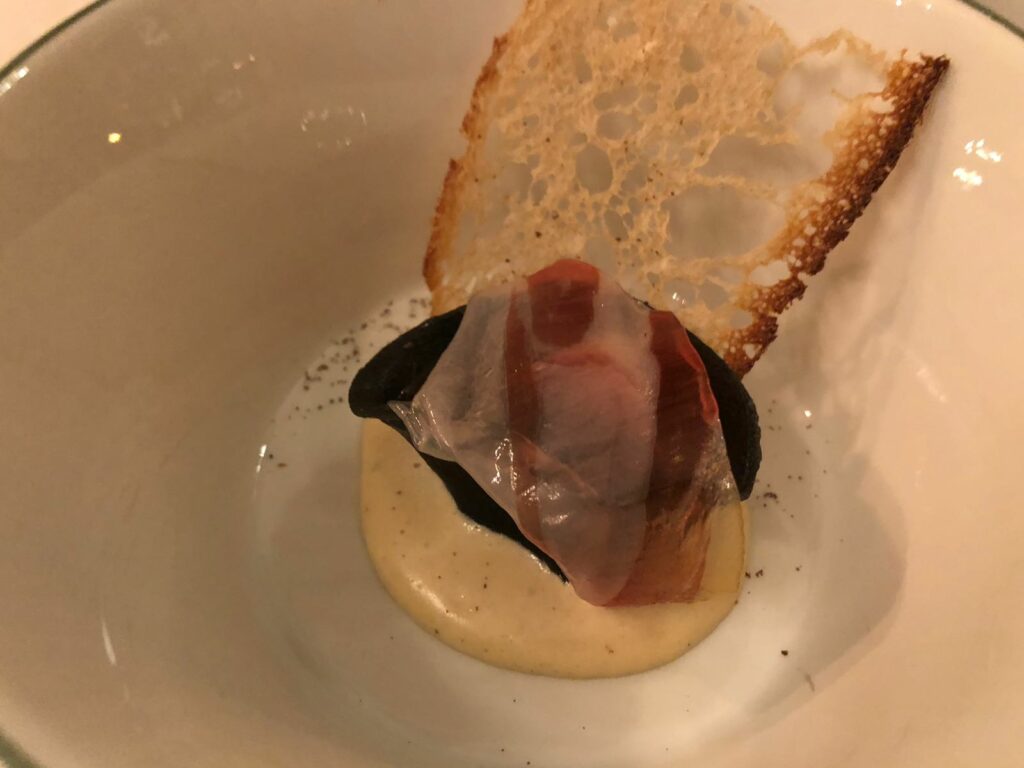
The chef followed with Saint Pierre filet, thick and cooked unilateral. The squid ink which featured in coloring the ravioli was used as a sauce. It provided a sweet touch. This was clever. Great artichokes and cockles were the other components of this very nice Saint Pierre (translated as John Dory, even though have never seen one in America!).
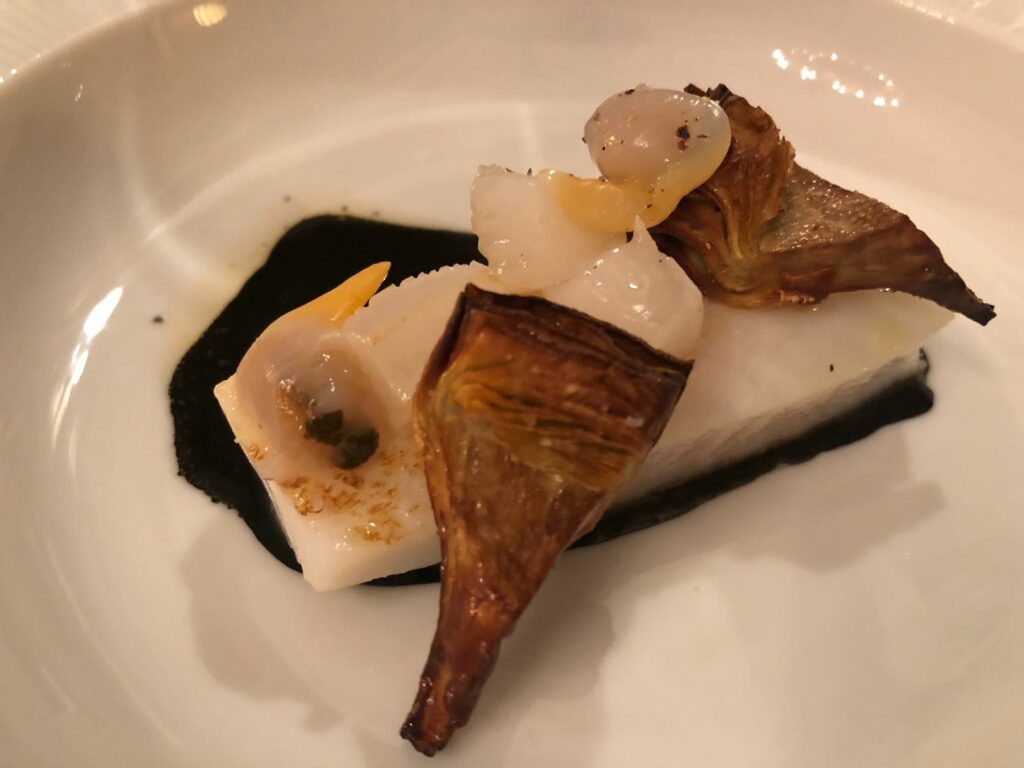
The final savory course was the saddle of lamb which was said to be “suckling,” but should be characterized as young lamb which has eaten grass. It was good, but not on par with the best I have seen in France with a multi-layered and deep taste. This may be why the chef topped it with eel glazed with soya and a generous serving of thickly sliced truffles. The accompaniments impressed me more than the lamb itself. The dish had a Béarnaise sauce on the side, which is a forgotten art, and pommes soufflé, which is another forgotten art. The dish also had endives braised with feta and tarama, reminiscent of the remarkable Turkish chef Kaan Sakarya’s artichokes with wild herbs and tarama. Finally, the dish had an ethereal gnocchi with bulots and shaved truffle. This was a very good terre-mer dish. The wine, selected by the sommelier, 2014 La Grande Ourse from the Southern Rhone, was an elegant Grenache dominated red, perhaps a tad monolithic for this level of complexity.
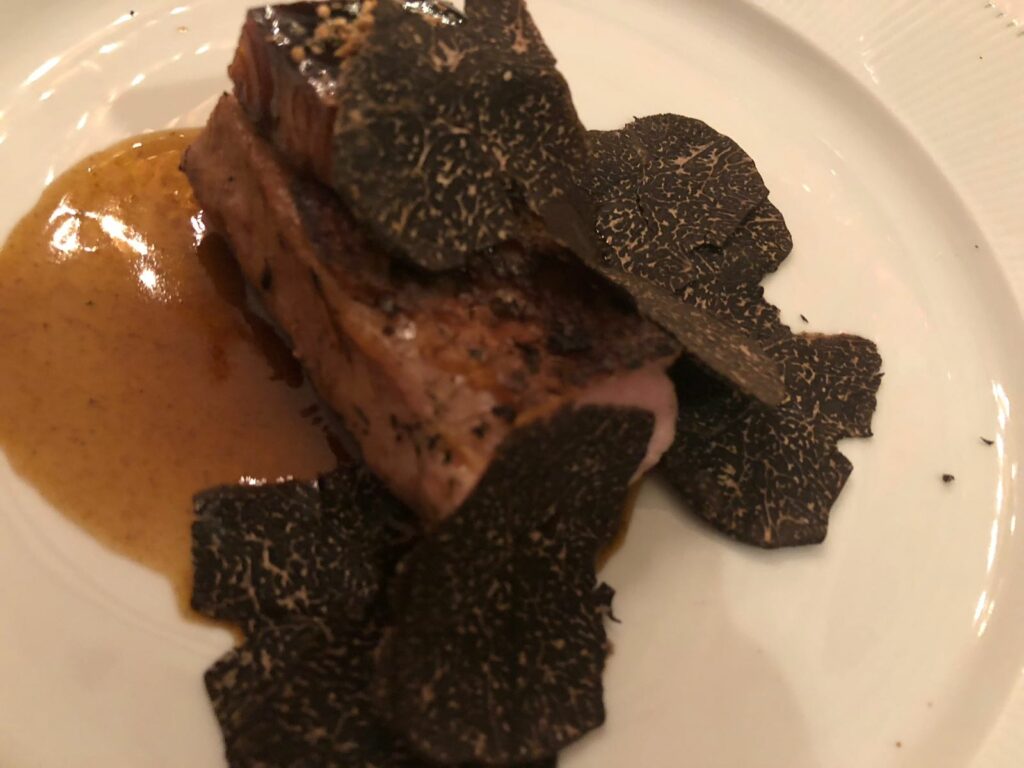
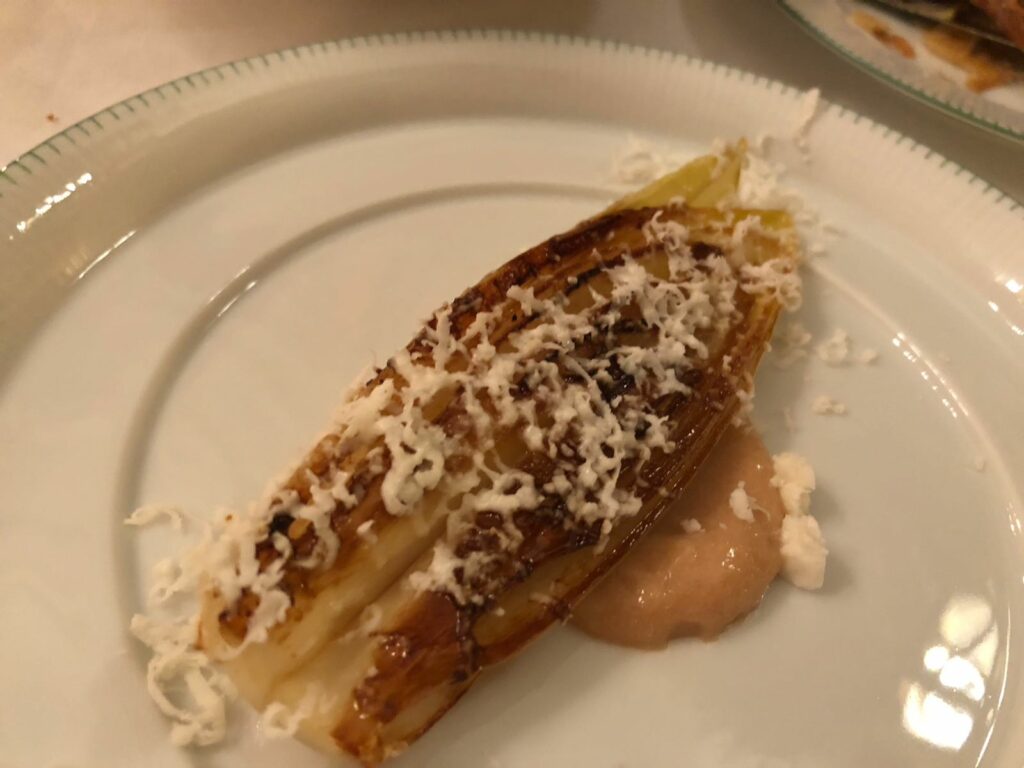
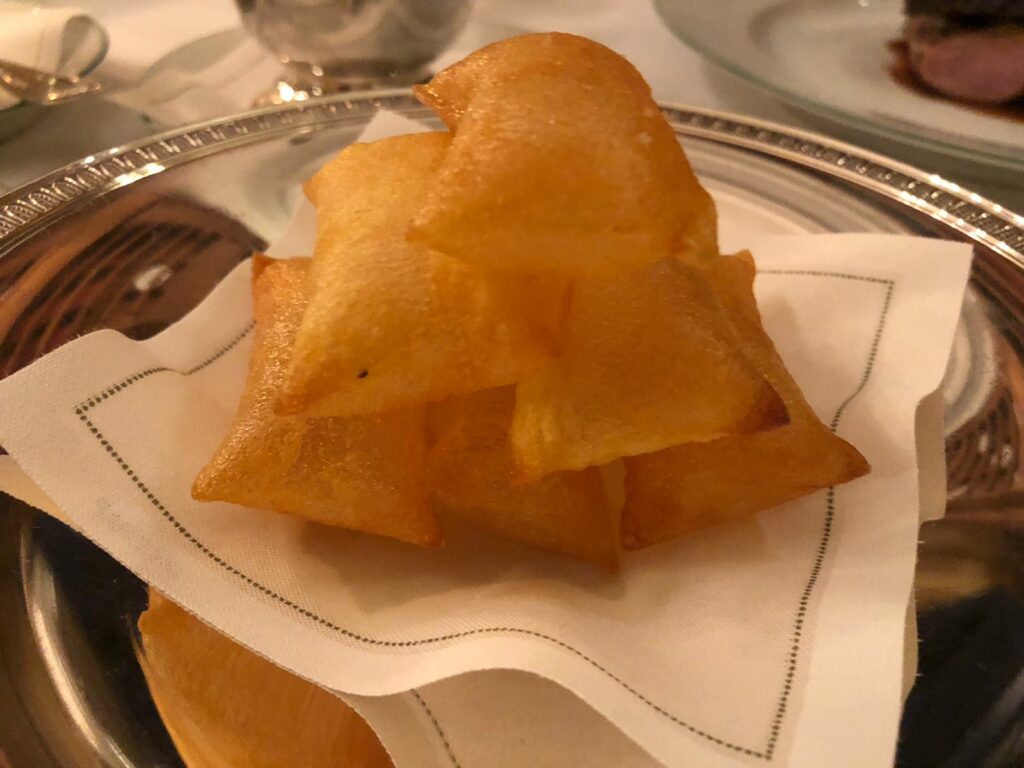
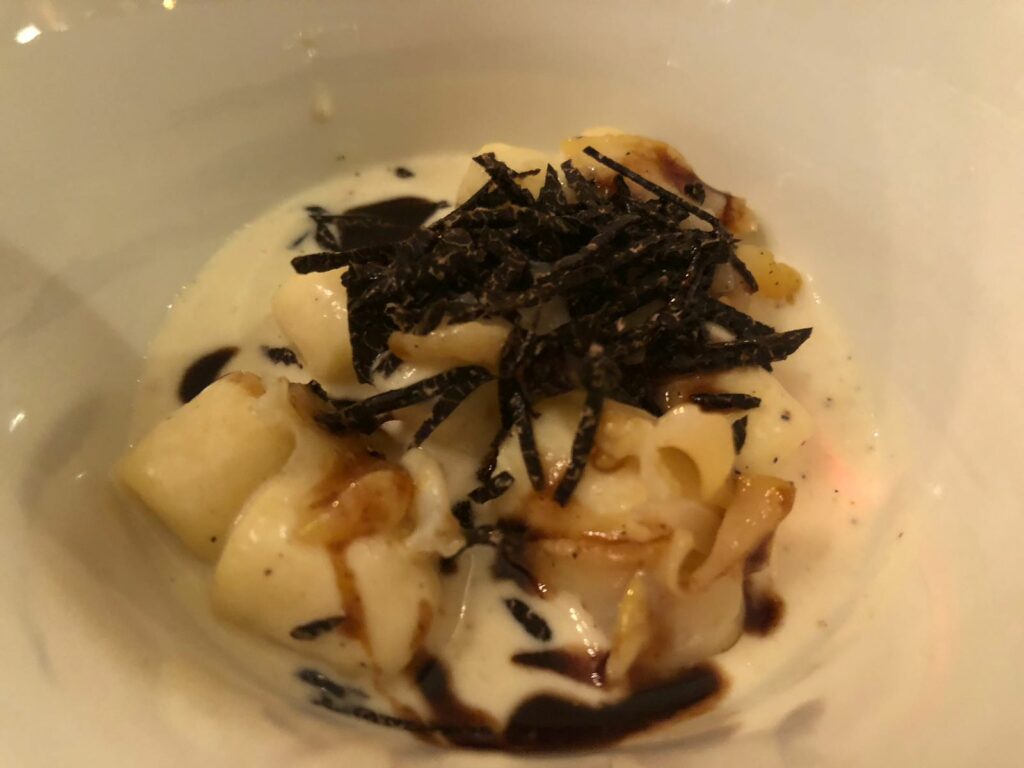
The cheese course was very good: Livarot, Reblochon, and Bleu d’Auvergne. The wine pairing was also top notch this time: a complex 2013 Cote du Jura from Macle. Desserts were the following: a sorbet of lychee and rose; cream of citron with coriander and pistachio; and an arlette with exotic fruits, coulis of mango and ginger. They were light and savory, a perfect ending to a sumptuous meal before coffee with mignardises and remarkable vanilla and white chocolate macaroons.
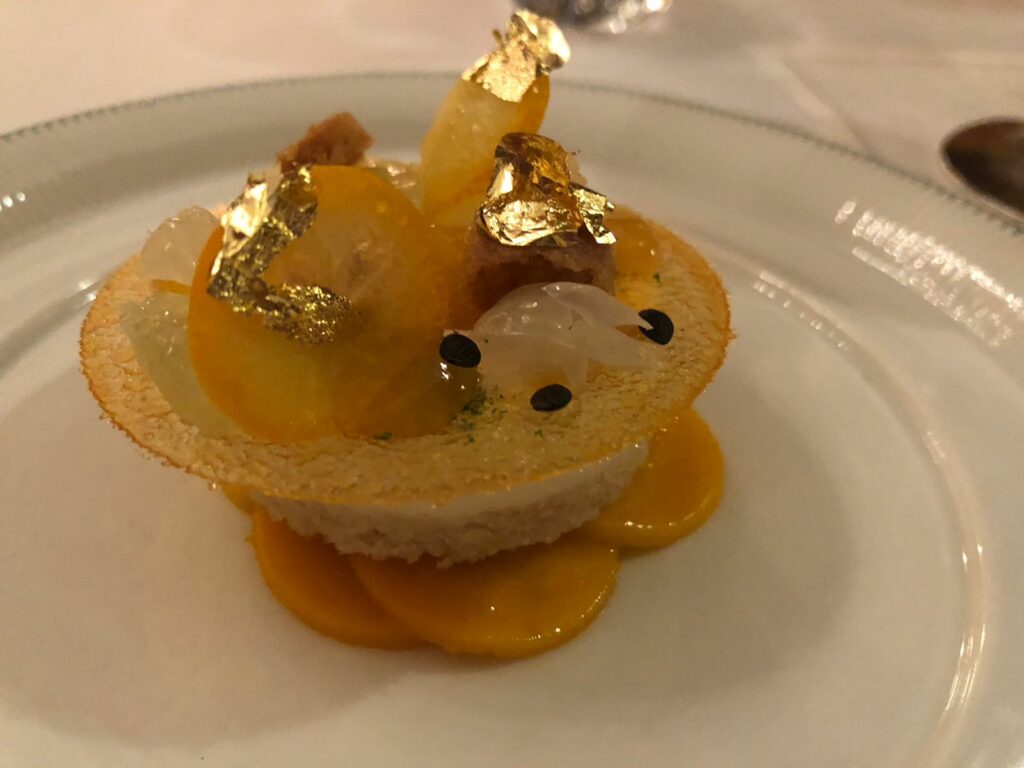
July 2018 Meal
If our first meal was excellent, the second meal was outstanding. I should say it was one of the best four to five meals I have had in Europe or America in the last few years. We started in the beautiful lounge with a Dhondt-Grelletchampagne to accompany amuses. We were then seated and asked for Krug to accompany our first course: langoustines. The Krug was so lush,minerally, and elegant. It is hard to resist when served by glass.
The langoustine dishes were presented successively as a trio: tempura, raw, and a la plancha. The sweet langoustine was of pristine quality, on par with the Table d’Aki and L’Ambroisie versions. The tempura was presented with an herbal sauce enriched by langoustine coral. The tuna bottarga on top turned out to be a good touch. The raw langoustine with cream of buffalo milk and thinly sliced radishes was even more interesting anddecadently simple. At this point we switched to a glass of a very pure and minerally Riesling with precision: 2016 Ostertag, Muenchberg. This Riesling also accompanied the sweet and juicy langoustine a la plancha, whose natural sweetness was enhanced with a contrasting intense/iodized element: the juice of the langoustine head. Diced pineapple, ginger and confit lemon were used judiciously for overall balance. In lesser hands and by changing the proportions, this dish could end up becoming a mumble-jumble of discordant flavors. I may surmise (maybe wrongly) that the minimalist school is advancing because it is very hard to concoct complex dishes which are not fussy, like this one.
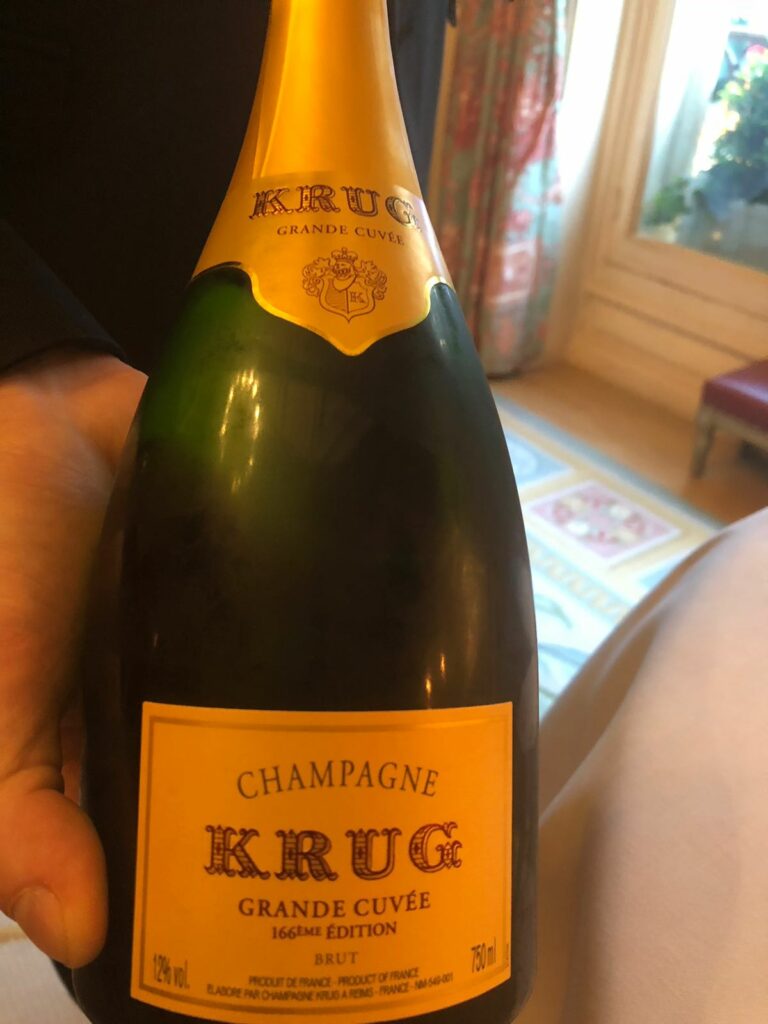
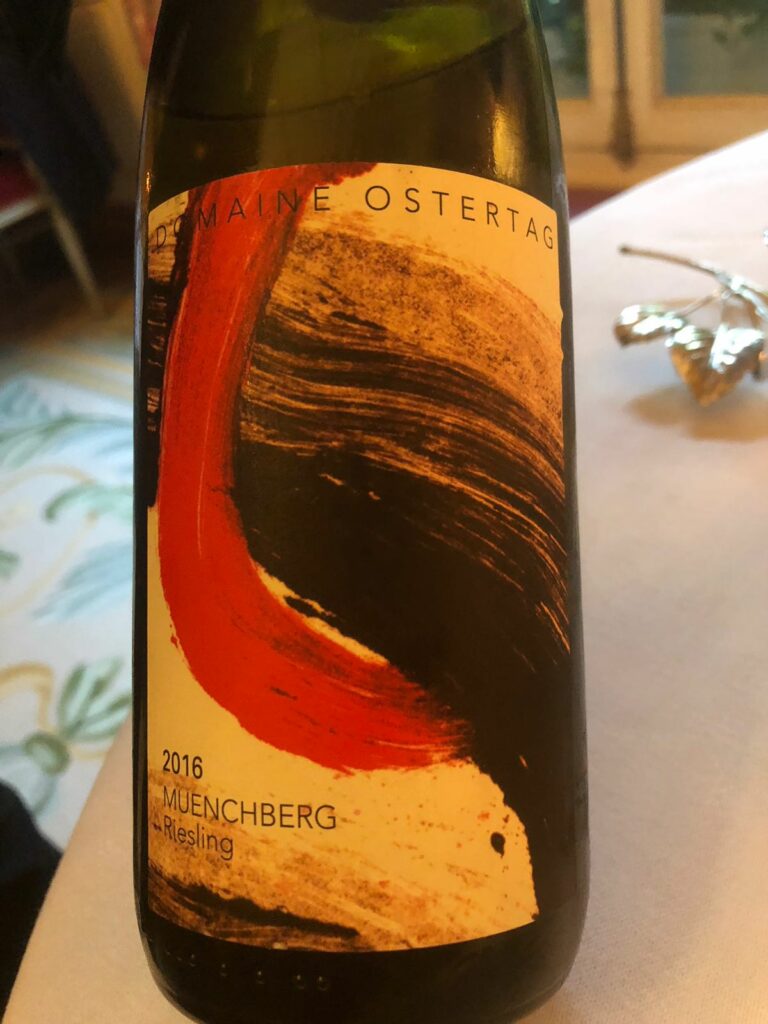
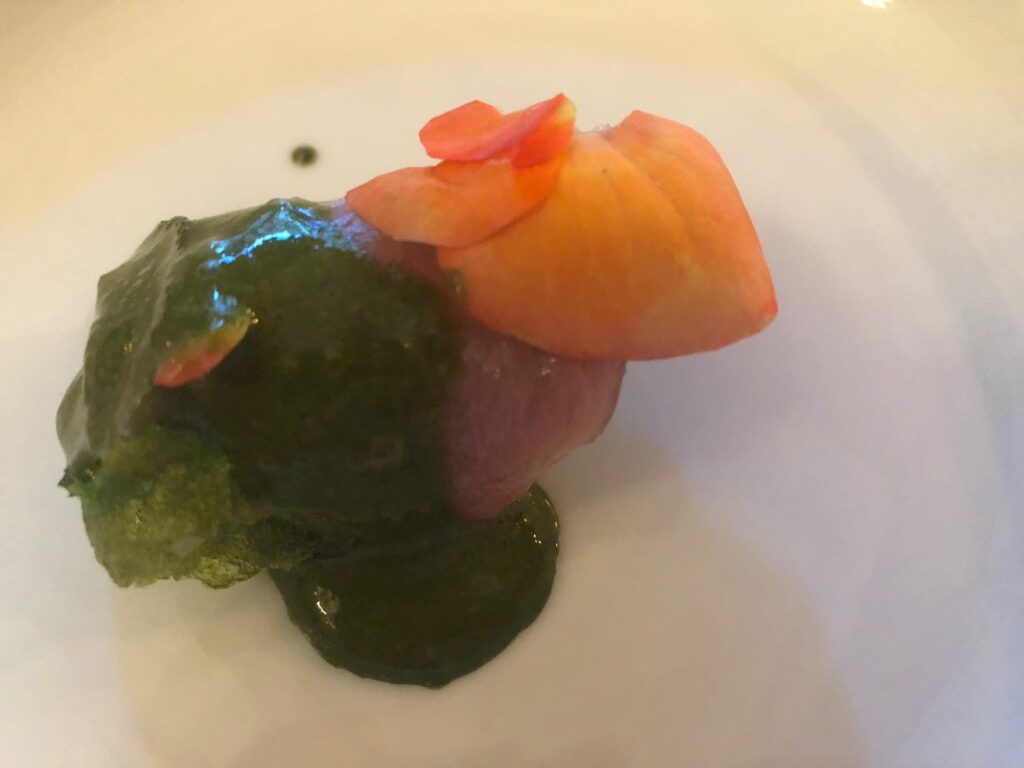
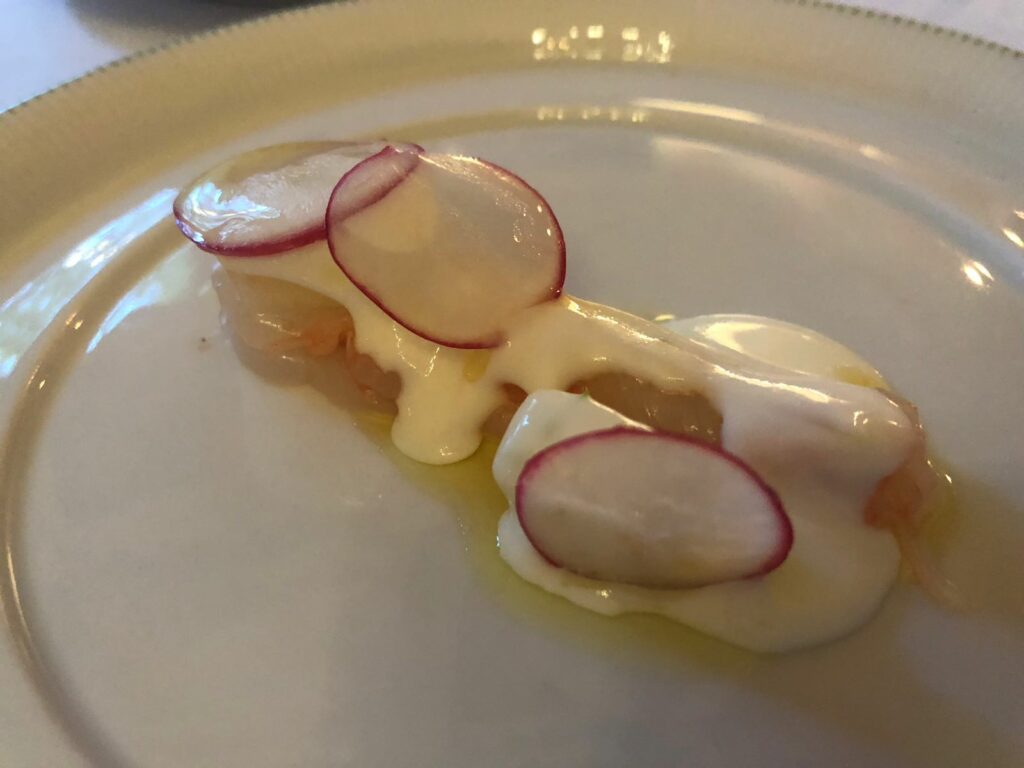
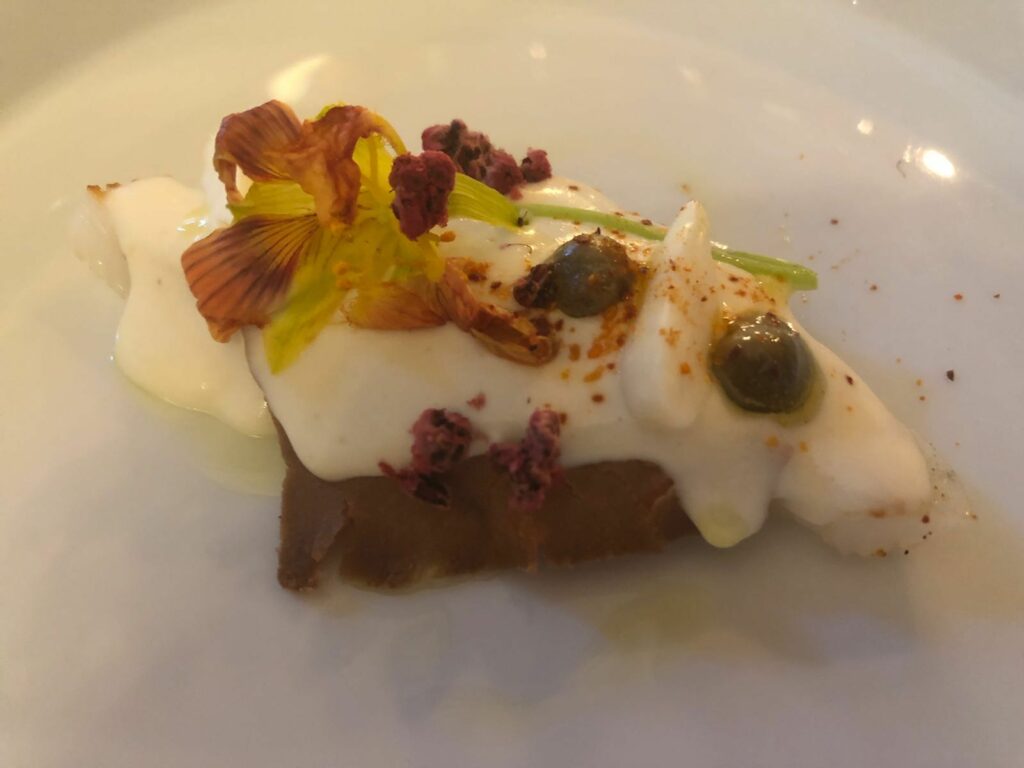
The next course was presented as a cuttlefish dish. Well, to me it was not. It was centered on “amanita caeserea” which is rarely found and only for brief periods. The cuttlefish was a decoy to bring out the subtle and nutty/earthy flavors of very fresh “amanita caeserea” wild mushrooms (which grow by the roots of oak trees). The dish displayed a careful choice of complimentary ingredients and textures, including thinly-cut barely grilled cuttlefish, slivers of fresh almonds, almond milk, and bottarga powder. We paired this with my favorite producer of whites in Iroleguy: Domaine Arretxea. They now make two (it used to be three) bottlings from particular parcels, including one that is easier to find called Hegoxuri. The gros and petit manseng in this soil impart depth and woody aromas and a strong backbone to the wine. Long maceration works for this wine. It is best to decant it.
We continued with two versions of fatty-meaty mackerel. The first version consisted of a thick fillet wrapped in lardo from Colonnata, flavored by XO sauce, and dusted with paprika (If you go to Colonnata, try Venanzio,which is a great trattoria with a good wine list). This dishwas accompanied by Salicornia and green zebra tomatoes. The fish was cooked uni-lateral on the skin. The next version was barely cooked, sitting on a rectangle shaped tomato heart, topped by black jambon from Bigarre. One dips it in buffalo cream. We accompanied these two wines with a Clos St. Vincent, “Le Clos”. I enjoy very much both the reds and whites from the tiny Bellet appellation, and kudos to the sommelier for the pairing. This full bodied Vermentino is underlaid by good acidity and is thankfully not too aromatic or fruity. It carried itself well against the intense-fatty flavors of the dishes.
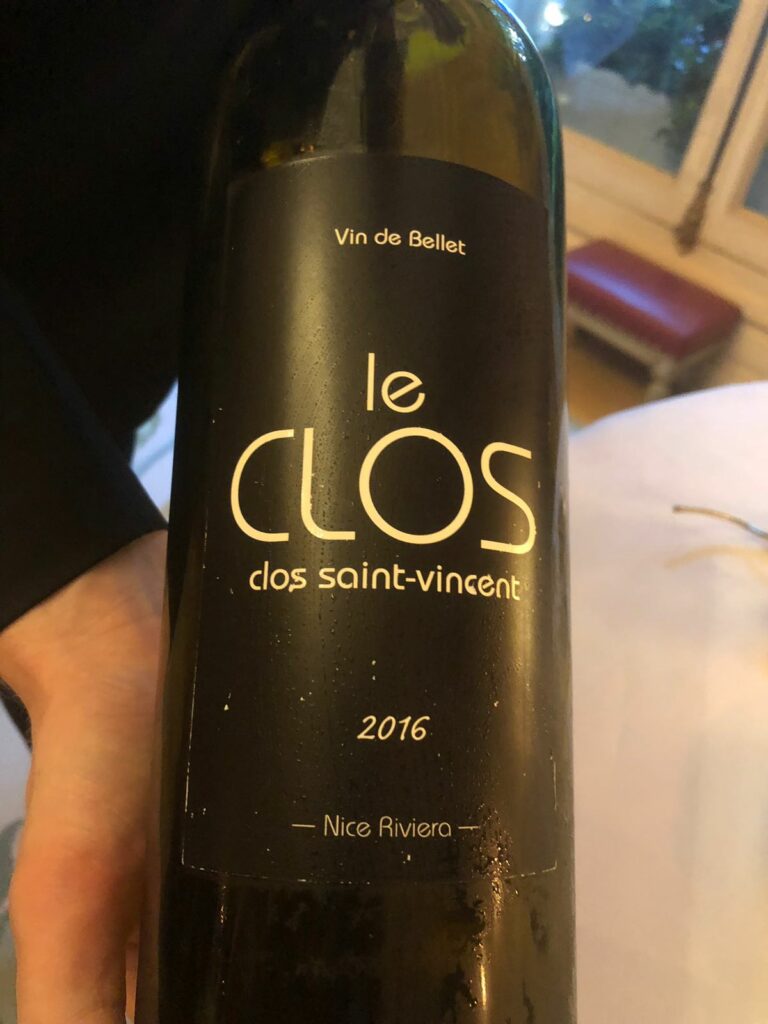
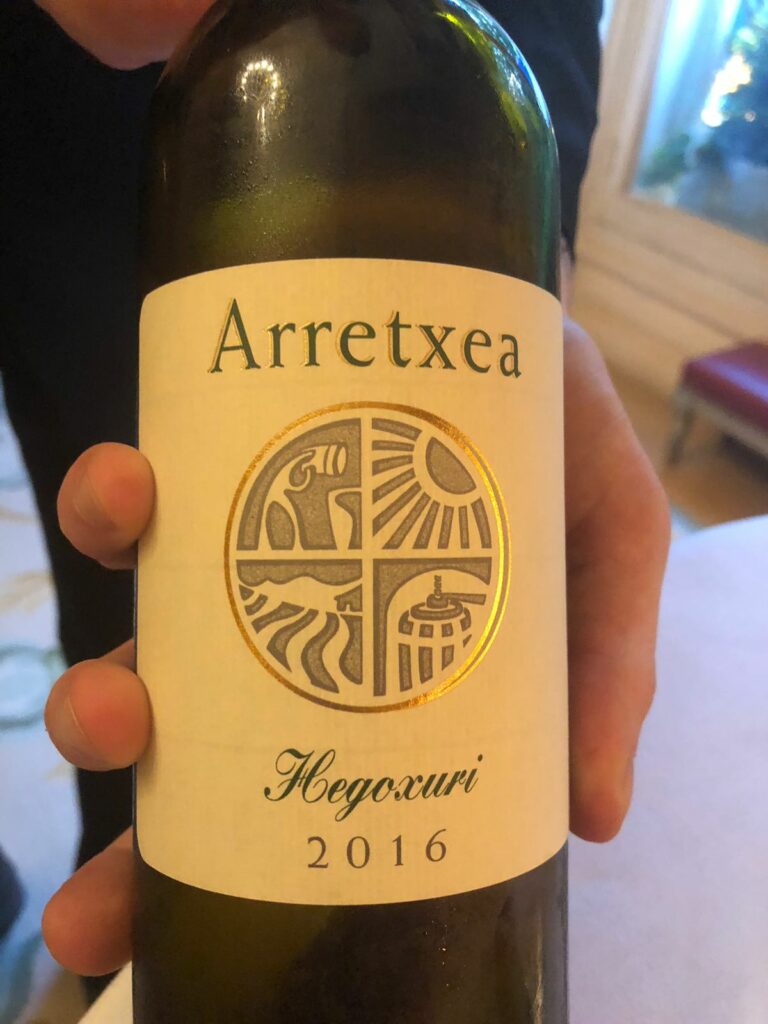
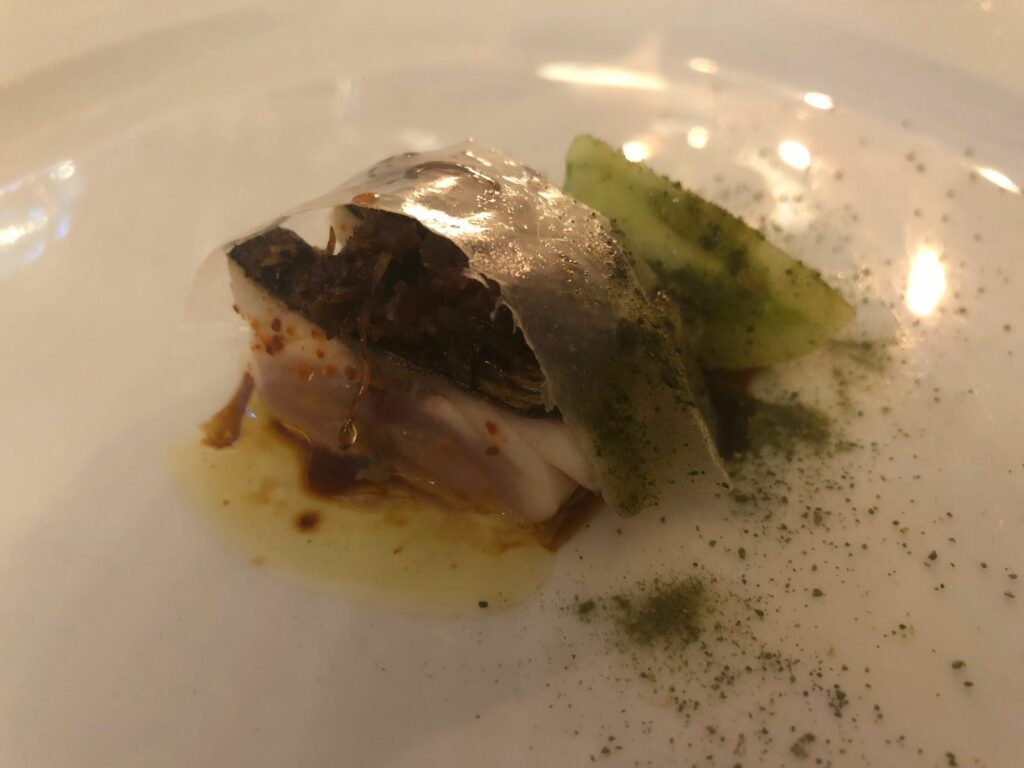
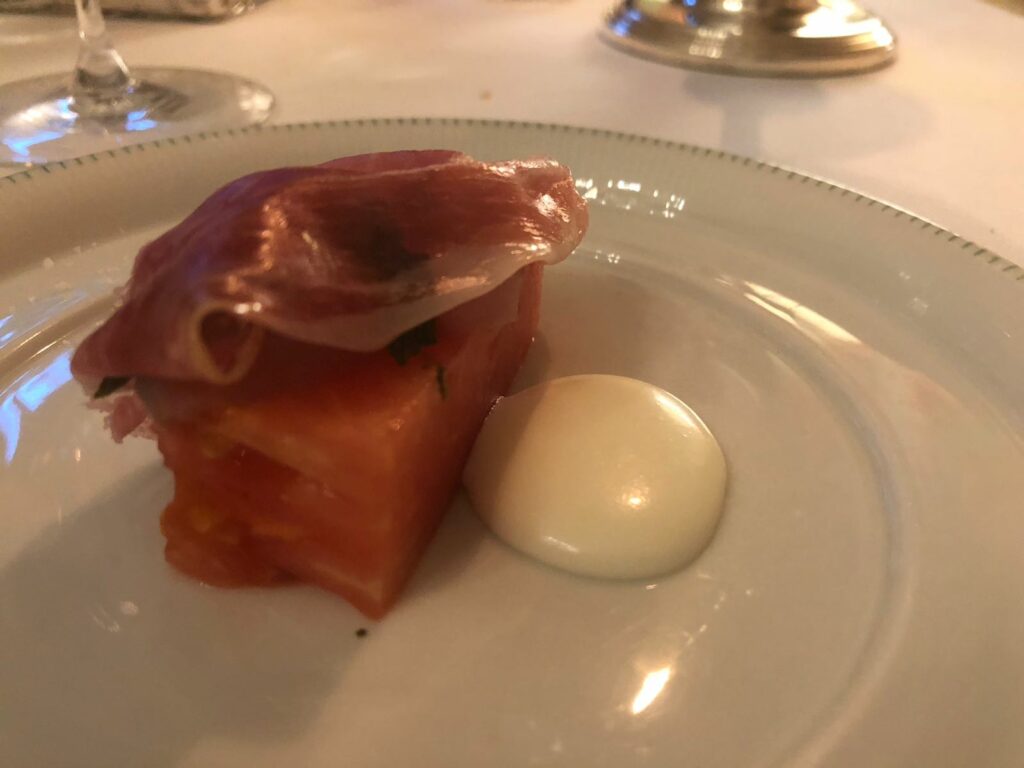
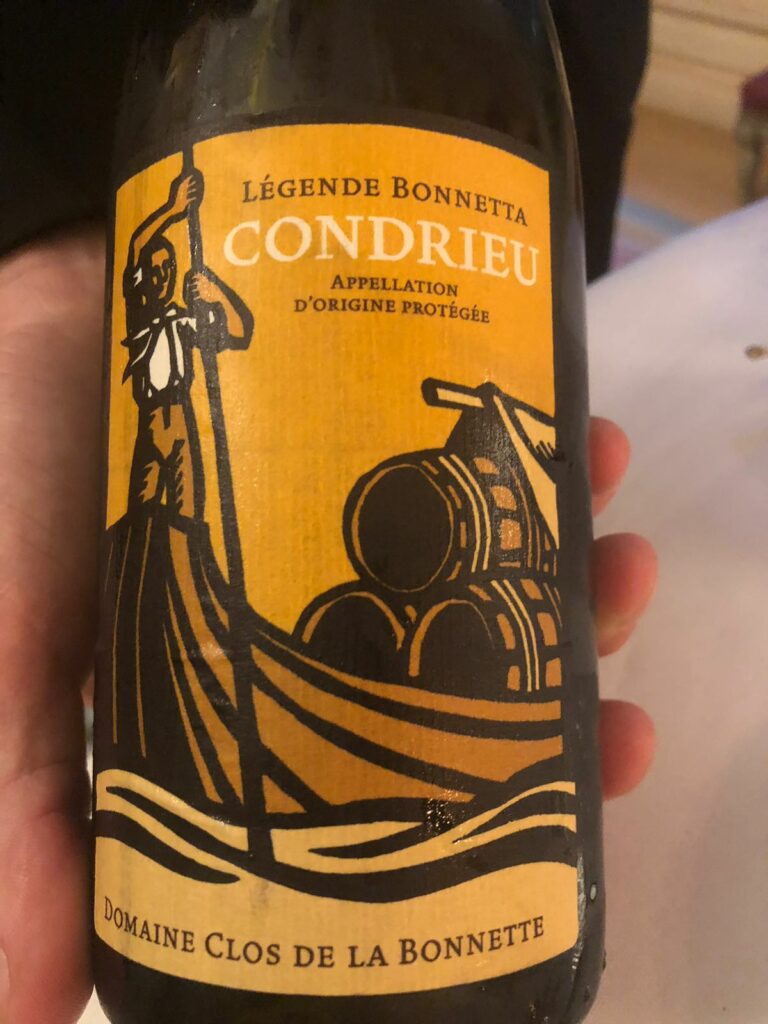
Next the sommelier came with a bottle of 2016 Condrieu“Clos de la Bonnette”. I guessed correctly that we would have lobster. Both aromatically and texture-wise Condrieumarries well with lobster. So we did have lobster. Firstly, a blue lobster was presented alive. I am not a fan of lobster sashimi, and fortunately the lobster was cooked. Not a single part of the lobster was wasted. The tail was cooked a la plancha, dressed with sabayon and a good dollop of caviar. Somehow the chefs imparted the scents of thyme and oregano to the lobster, but I did not see the herbs. Following this, the chef sent an excellent ravioli stuffed with lobster egg and flavored by a bisque of lobster. Thirdly, they brought us the claw of lobster tempura, dressed with an herbal sauce. Actually I found the lobster-caviar matching to be better with the grilled tail, than with the claw tempura, as was the case in the March meal.
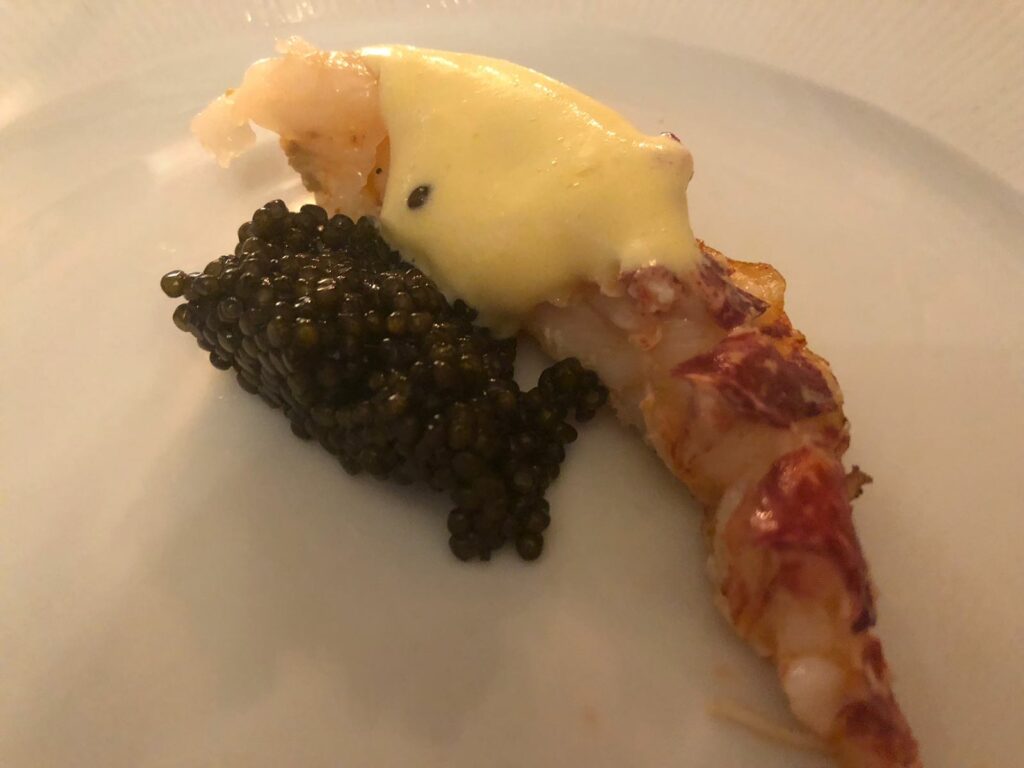
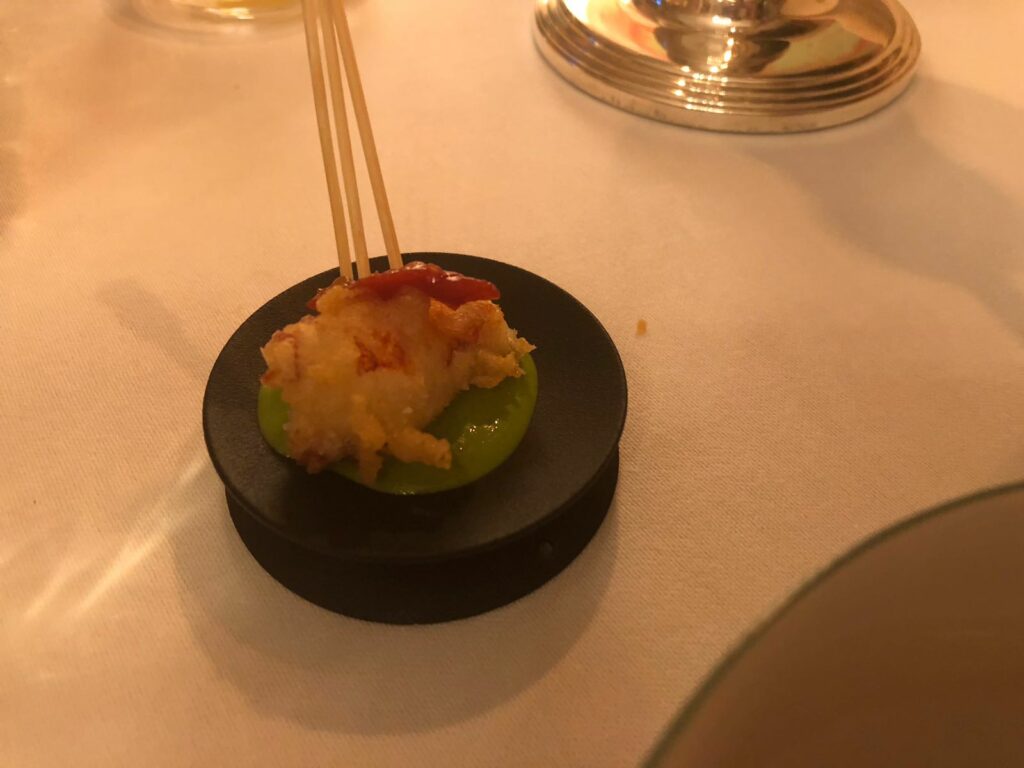
Next the sommelier presented us with a bottle of 2014 Jerome Bressy, “Domaine Gourt de Mautens”. I had tried the red of this wine (with pigeon) and the white (with avery rich ecrevisse dish) and was excited to taste it again. This is a wine with good tension, captivating wild herb aromas, and good presence on the palette. A gelatinous fish is ideal with it, such as the turbot!
Cut from the bone, the roasted turbot was the same level as the best examples (It was on par with the great examples at La Table in Paris and Al Kostat in Barcelona). Following the rich lobster, the chef chose an herbal-tart-grassy sauce with the turbot, with an infusion of sorrel, sorrel leaves, avocado, salicornia, and chrysanthemum flower. The flavors blended well together, like a happy marriage of opposites.
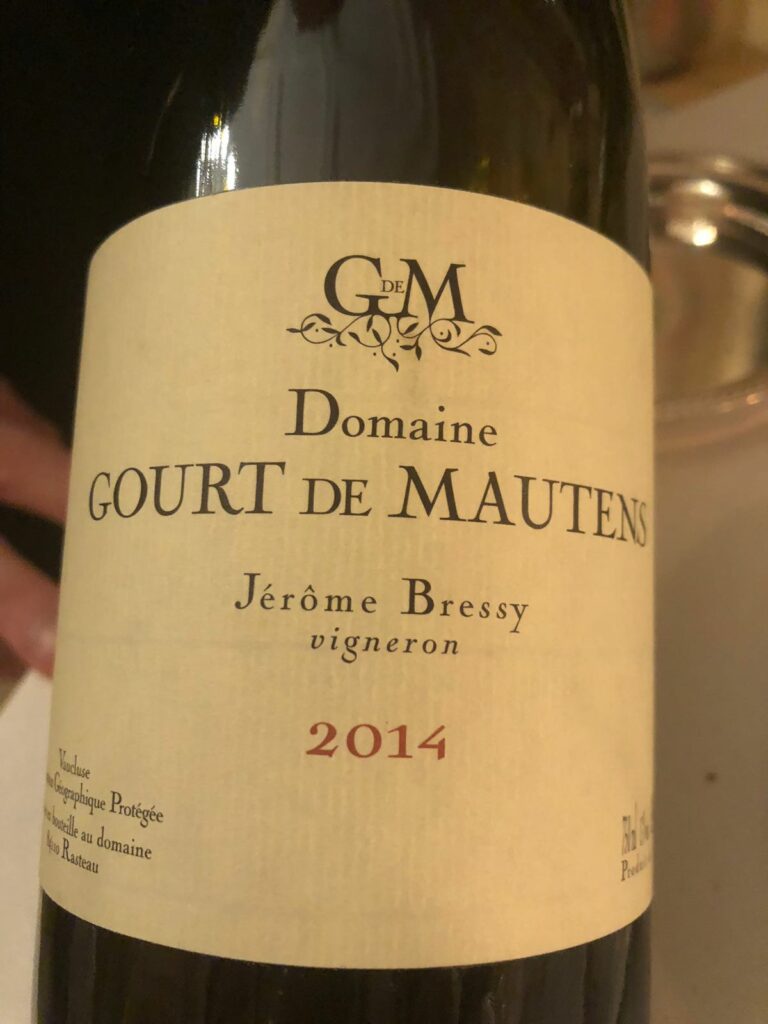
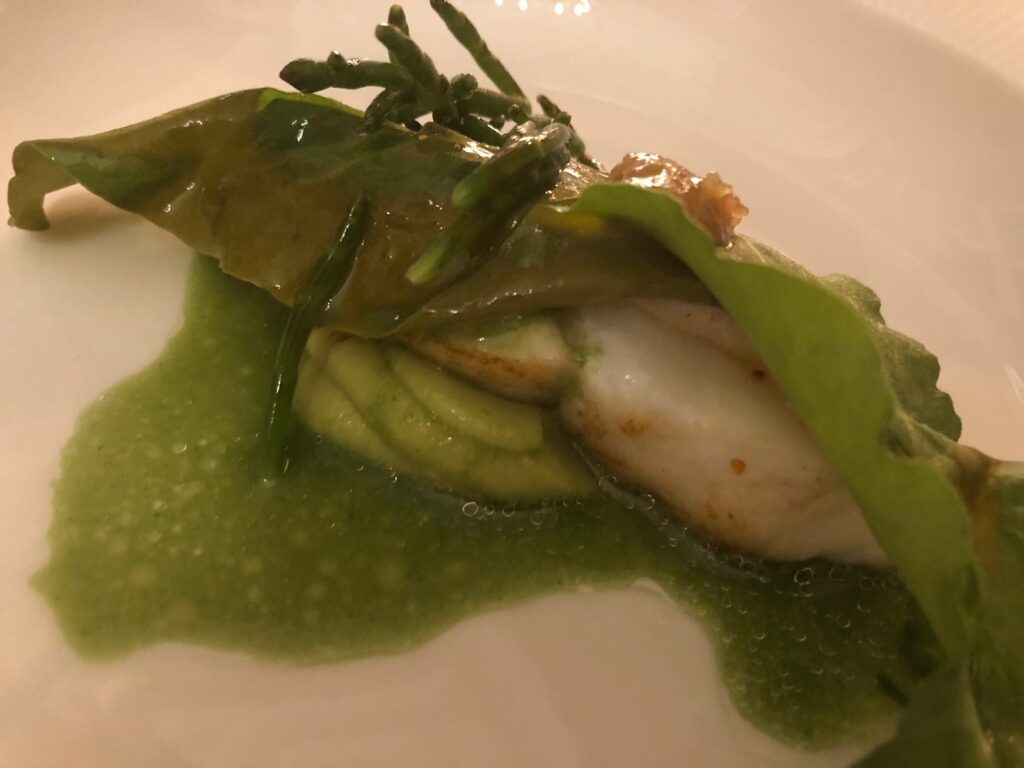
The final savory course was pigeon. The breast of the pigeon was as good as Ducasse used to serve in Louis XV, before he decided to make it simpler to suit his average clientele. Chef Pele offered us a “salmis of pigeon” with an acidulated sauce enriched with the internal organs. There was a touch agrume (maybe orange confit) and grassy (maybe sorrel) taste and an olive scent too. The dish had depth and a tremendous flavor profile. It was not overly gamey. There were four more small portions with the breast. The leg was served with a sauce béarnaise. The wing was served with confit tomatoes and bigorre black ham on top of vitello tonnato cream. There were amazing pommes soufflées, like in the March meal. But maybe the portion (besides the breast) that left most lasting impression was the roasted eggplant. Glazed with miso, dusted with roasted white sesame seeds, paired with the pigeon heart, and sitting atop feta cheese cream enriched by pigeon jus, the eggplant was a triumph.
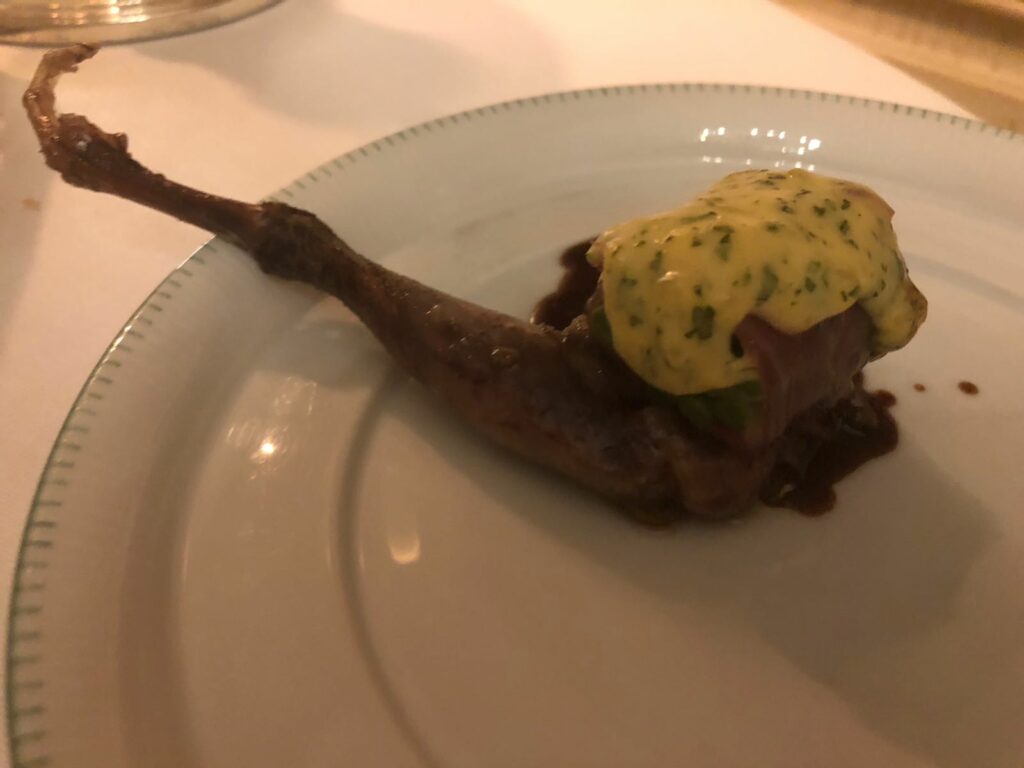
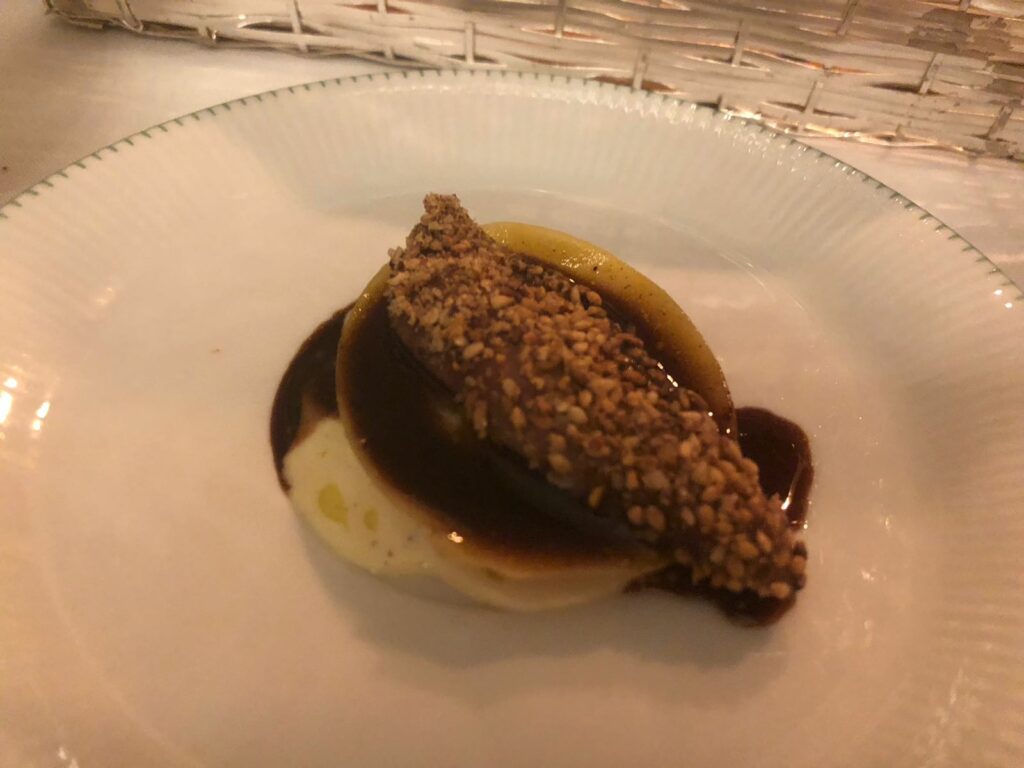
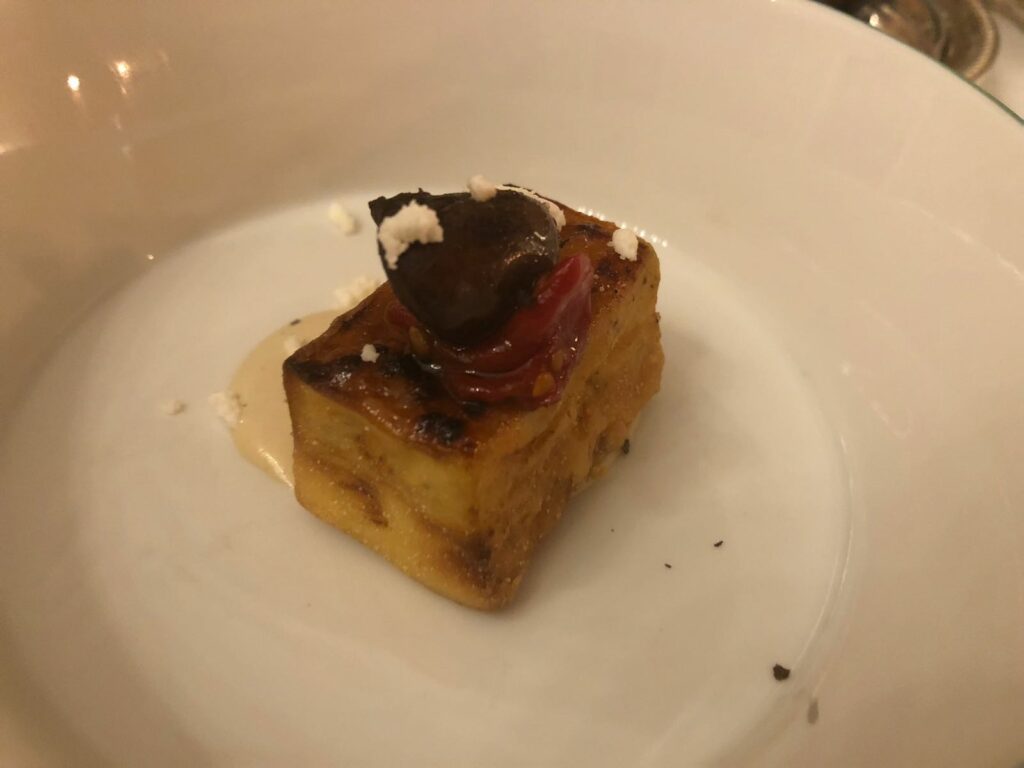
Because the dish was so rich, we decided to have not a glass, but a bottle of a favorite Languedoc syrah that I had chosen: 2002 Peyre Rose, cuvee Leone. Full bodied, yet complex and elegant, the wine was a perfect match with the salmis of pigeon.
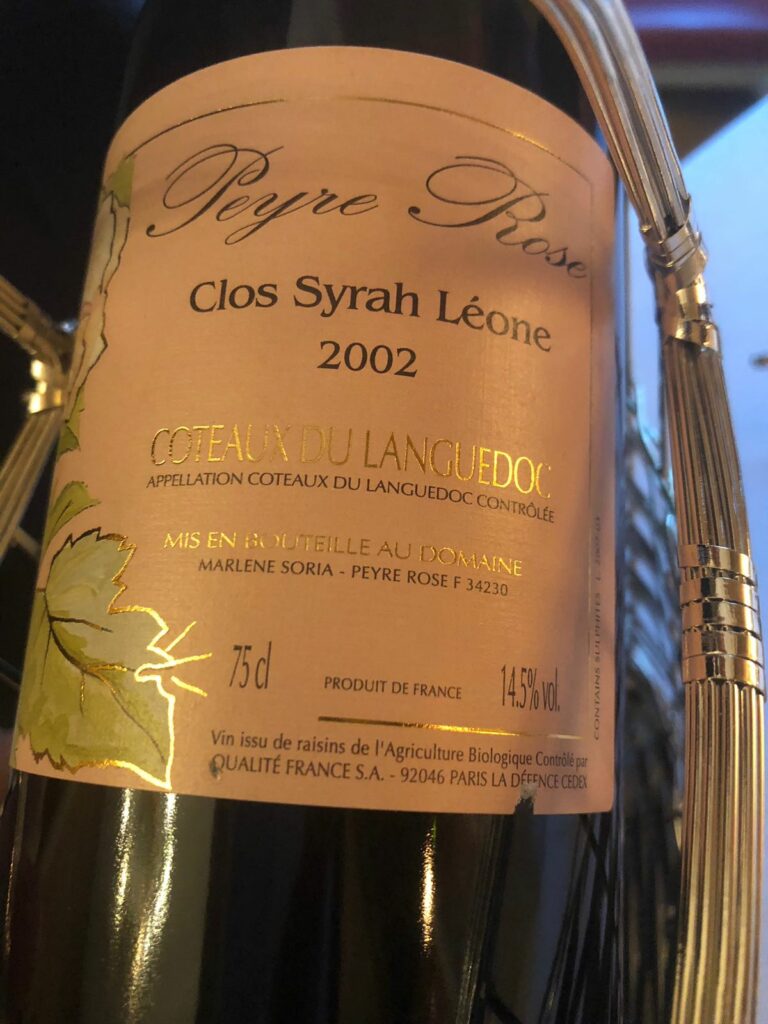
The cheeses that we chose were again ripe, and I especially noted the sumptuous brillat-savarin.
There were two surprises with the desserts. The “forgotten” taste was fresh top quality cherries, the like of which I used to find in my childhood in Turkey.
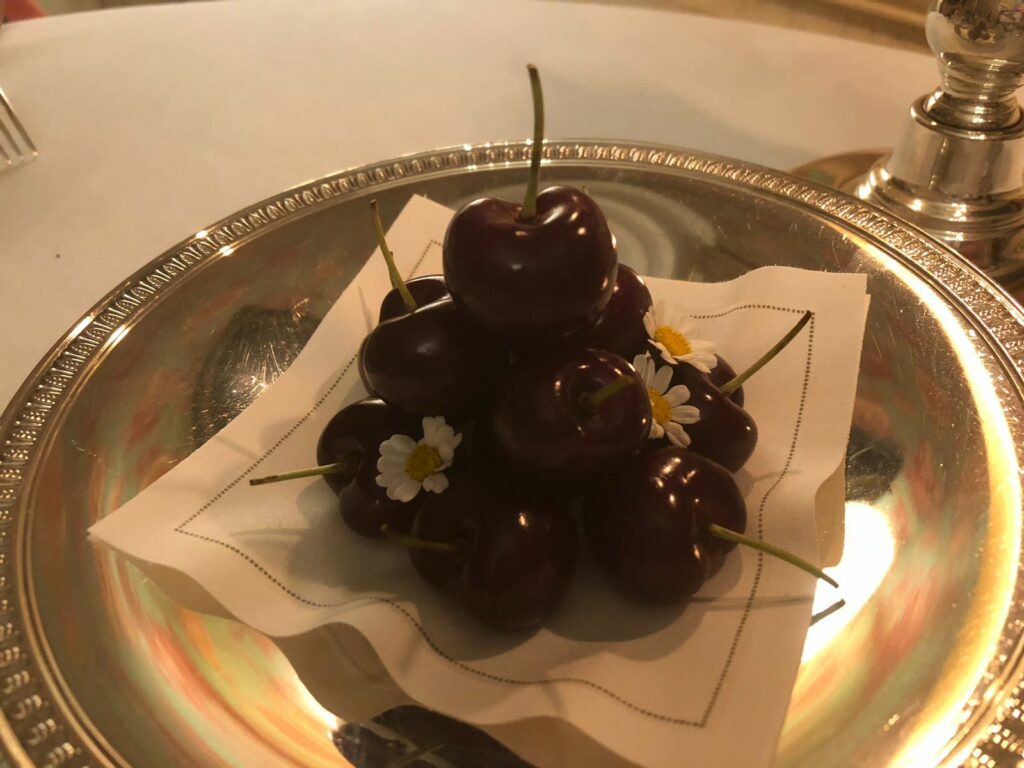
Secondly, we had a quite intense wild strawberry tart. It was served with a sorbet of herbs, cassis, and almonds. Well, I cannot say that they possessed the intensity-sweetness level available in Ingmar Bergman’s time which may have inspired him to shoot his masterpiece (Wild Strawberries), but they were very good indeed.
We did not complain when they served us a strawberry sorbet with a cream of mascarpone with nougatine. Neither did we have any problem with a dark chocolate soufflé with crème praline. We still managed to enjoy the chewy macaroons with coffee.
When I reflect on these two meals, one can find some recurrent themes and a particular style in Pele’s cuisine.
1. He likes dishes with an acidulated component in various guises.
2. He balances sweet and tart flavors with a lactic element.
3. He believes in fat/gelatinous textures and is not shy about using the best fat available (reminds me of Gambero Rosso which was a great Italian restaurant that has closed down).
4. His sense of proportion/balance is intuitively on target.
5. Clarity of taste comes first for him, and he centers his dishes around a main element in the spirit of Nouvelle Cuisine.
6. Most of the dishes are cerebral, but since they taste so good and look so simple, they do not come across as “creative,” like at Noma, at Can Roca, or at Mugaritz. This is actually deceptive as we witness here the marriage between intelligence and know-how (know-how of ingredients and precise, rigorous kitchen work). During difficult times when sloppiness parades as “cooking the boundaries of cuisine,” this is no mean feat.
EVALUATION: 18.5/20
